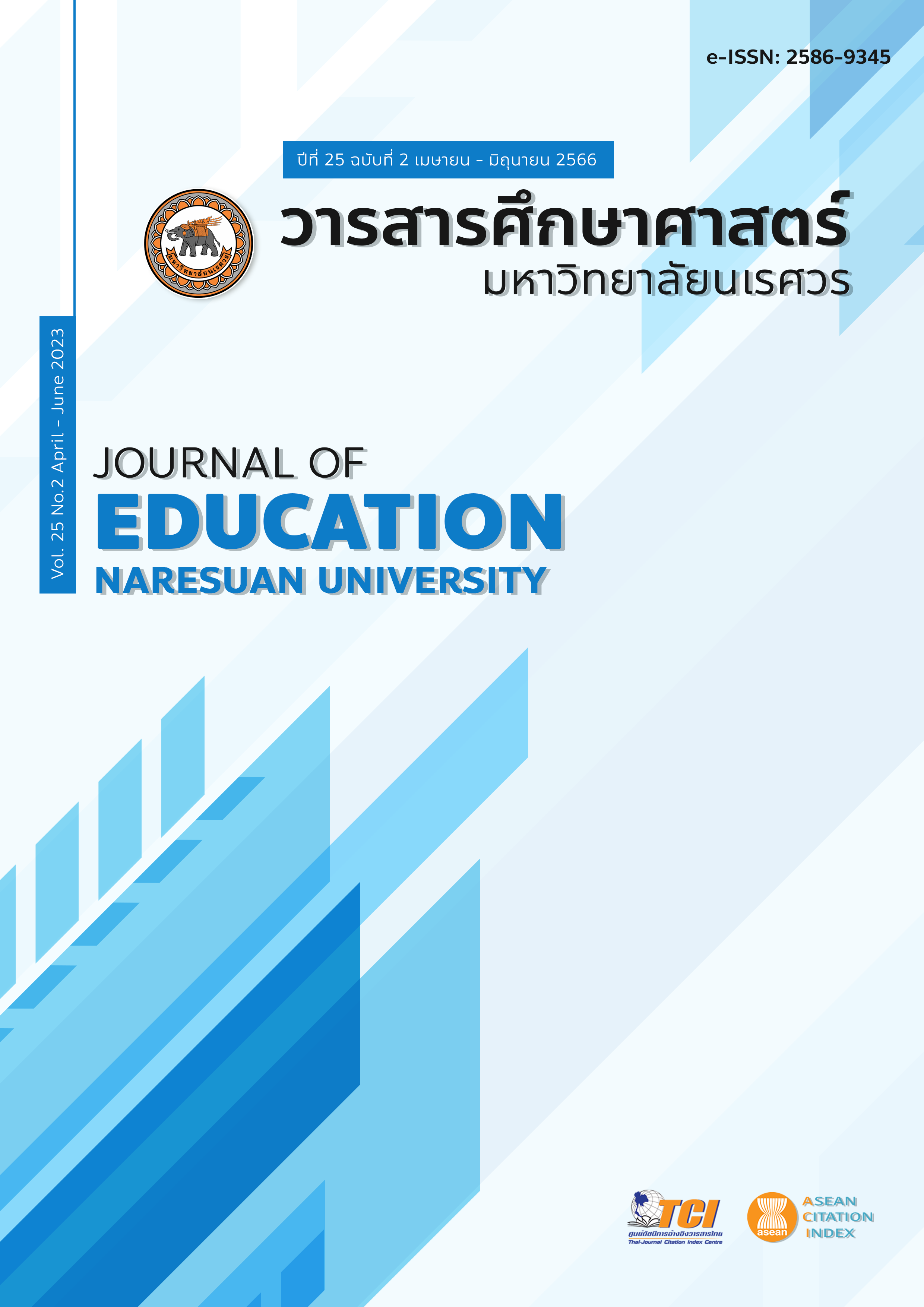DEVELOPMENT OF A CLINICAL DIAGNOSIS INSTRUCTIONAL MODEL WITH BLENDED LEARNING TO ENHANCE CLINICAL DIAGNOSIS REASONING IN CLINICAL-YEAR MEDICAL STUDENTS การพัฒนารูปแบบการจัดการเรียนการสอนกระบวนการวินิจฉัยโรคแบบผสมผสาน เพื่อส่งเสริมการให้เหตุผลในการวินิจฉัยทางการแพทย์ของนักศึกษาแพทย์ในระดับชั้นคลินิก
Main Article Content
Abstract
The aim of this research was to develop a blended learning instructional model to enhance clinical diagnosis reasoning skill of clinical-year medical students. The objectives were 1) to survey and analyze teaching and learning situation in clinical diagnosis class, 2) to develop a blended learning instructional model for clinical diagnosis teaching, 3) to study the results of the blended learning for clinical diagnosis, and 4) to compare the learning results between traditional and blended learning. The sample group of this research was forty-five fifth-year medical students of Faculty of Medicine, Naresuan University, who were studying at the Medical Education Center of the Provincial Hospital, with the research period for 12 weeks. This research was two groups of quasi-experimental study: traditional learning group and blended learning group. The data collection tool was the diagnosis clinical reasoning self-assessment test which evaluates four skills following clinical diagnosis process: data selection, problem representation, differential diagnosis and diagnosis. In accordance with the result showed blended learning was able to promote diagnosis reasoning skill at .05 level of significance. It was also more effective than traditional learning at .05 level of significance.
Article Details

This work is licensed under a Creative Commons Attribution-NonCommercial-NoDerivatives 4.0 International License.
The owner of the article does not copy or violate any of its copyright. If any copyright infringement occurs or prosecution, in any case, the Editorial Board is not involved in all the rights to the owner of the article to be performed.
References
Audétat, M. C., Lubarsky, S., Blais, J. G., & Charlin, B. (2013). Clinical reasoning: Where do we stand on identifying and remediating difficulties? Medical Education and Health Professions, 4(6A), 42-48.
Bordage, G., Grant, J., & Marsden, P. (1990). Quantitative assessment of diagnostic ability. Medical Education, 24(5), 413-425.
Bowen, J. L. (2006). Educational strategies to promote clinical diagnostic reasoning. New England Journal of Medicine, 355(21), 2217-2225.
Cutrer, W. B., Sullivan, W. M., & Fleming, A. E. (2013). Educational strategies for improving clinical reasoning. Current Problems in Pediatric and Adolescent Health Care, 43(9), 248-257.
Evans, J. S. B. T. (2008). Dual-processing accounts of reasoning, judgment, and social cognition. Annual Review of Psychology, 59(1), 255-278.
Garrison, D. R., & Kanuka, H. (2004). Blended learning: Uncovering its transformative potential in higher education. The Internet and Higher Education, 7(2), 95-105.
Harris, P., Connolly, J., & Feeney, L. (2009). Blended learning: Overview and recommendations for successful implementation. Industrial and Commercial Training. 41(3), 155-163.
Hoffman, K. G., & Donaldson, J. F. (2004). Contextual tensions of the clinical environment and their influence on teaching and learning. Medical Education, 38(4), 448-454.
Kintu, M. J., Zhu, C., & Kagambe, E. (2017). Blended learning effectiveness: The relationship between student characteristics, design features and outcomes. International Journal of Educational Technology in Higher Education, 14(1), 1-20.
Leape, L. L., Brennan, T. A., Laird, N., Lawthers, A. G., Localio, A. R., Barnes, B. A., Hebert L., B Newhouse, J. P., Weiler, P. C., & Hiatt, H. (1991). The nature of adverse events in hospitalized patients: Results of the Harvard medical practice study II. New England Journal of Medicine, 324(6), 377 - 384.
Lewin, L. O., Singh, M., Bateman, B. L., & Glover, P. B. (2009). Improving education in primary care: Development of an online curriculum using the blended learning model. BMC Medical Education, 9(1), 1-7.
Loyjew, A., & Sunthornlohanukul, S. (2014). Modified essay question assessment of reasoning thinking skills in introduction to medicine course. In Tracks & Trends in Healthcare (p. 187). Songkla: Baitul Printing. [in Thai]
Makhdoom, N., Khoshhal, K. I., Algaidi, S., Heissam, K., & Zolaly, M. A. (2013). Blended learning as an effective teaching and learning strategy in clinical medicine: A comparative cross-sectional university-based study. Journal of Taibah University Medical Sciences, 8(1), 12-17.
Norman, G. (2005). Research in clinical reasoning: Past history and current trends. Medical Education, 39(4), 418 - 427.
Pereira, J. A., Pleguezuelos, E., Merí, A., Molina-Ros, A., Molina-Tomás, M. C., & Masdeu, C. (2007). Effectiveness of using blended learning strategies for teaching and learning human anatomy. Medical Education, 41(2), 189-195.
Round, A. (2001). Introduction to clinical reasoning. Journal of Evaluation in Clinical Practice, 7(2), 109–117.
Sadhuwong, K., Koraneekij, P., & Natakuatoong, O. (2016). Effects of a blended learning model integrating situated multimedia lessons and cognitive apprenticeship method on the clinical reasoning skills of nursing students. Journal of Health Research, 30(6), 421-431.
Sinthuchai, S., Chiengta, P., & Bunsonti, N. (2010). Clinical reasoning: Concept and application for learning and teaching in nursing students. Nursing Journal of The Ministry of Public, 28(2), 27-40. [in Thai]
Stacey, E., & Gerbic, P. (2008). Success factors for blended learning. Proceedings Ascilite Melbourne 2008 (pp. 964-968). https://www.ascilite.org/conferences/melbourne08/procs/stacey.pdf
Sungkang, I. (2019). The trend of medical prosecutions is rising steadily. Retrieved April 7, 2021, from https://www.hfocus.org/content/2019/01/16725 [in Thai]
Tehrani, A. S. S., Lee, H., Mathews, S. C., Shore, A., Makary, M. A., Pronovost, P. J., & Newman-Toker, D. E. (2013). 25-Year summary of US malpractice claims for diagnostic errors 1986–2010: An analysis from the national practitioner data bank. BMJ Quality & Safety, 22(8), 672-680.
World Health Organization. (2016). Diagnostic errors: Technical series on safer primary care. Geneva: World Health Organization.
Young, J. Q., Van Merrienboer, J., Durning, S., & Ten Cate, O. (2014). Cognitive load theory: Implications for medical education: AMEE guide no. 86. Medical Teacher, 36(5), 371-384.


